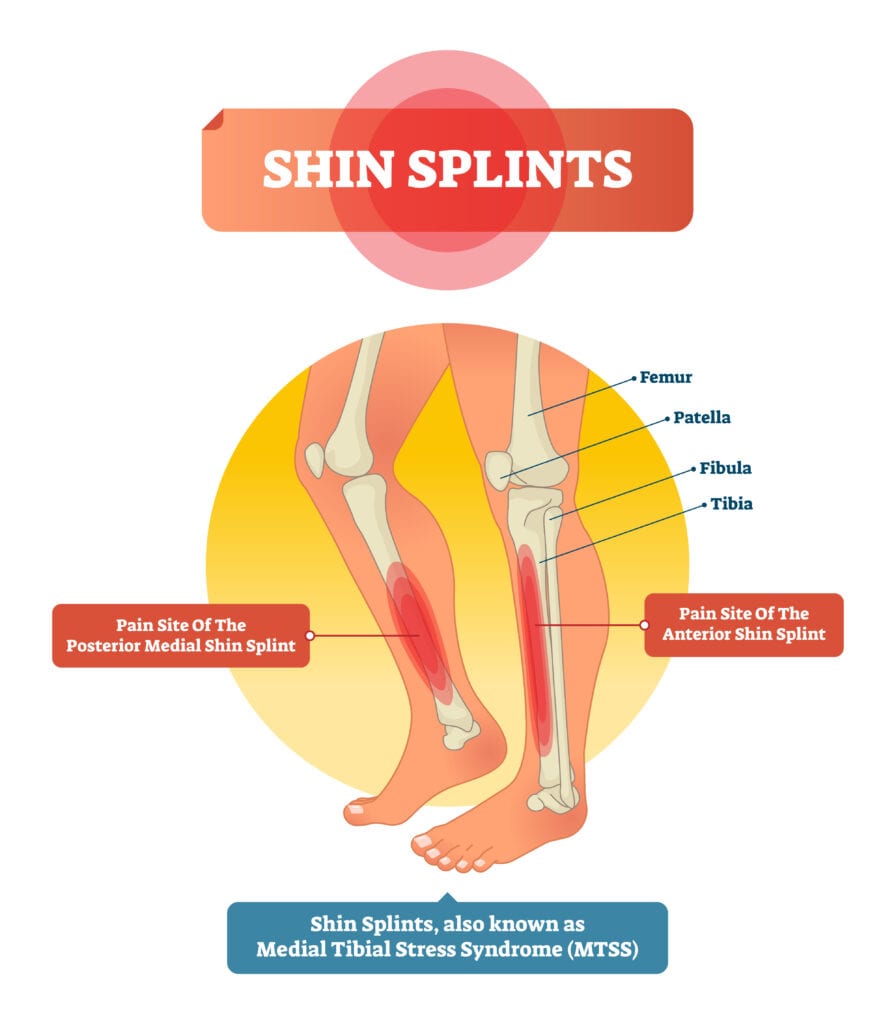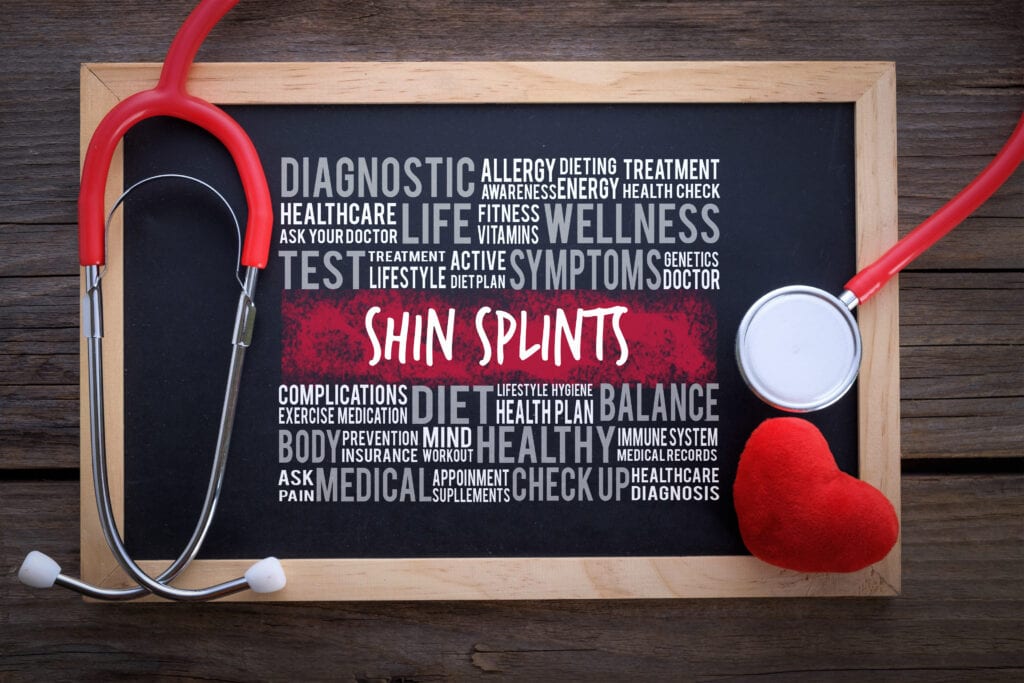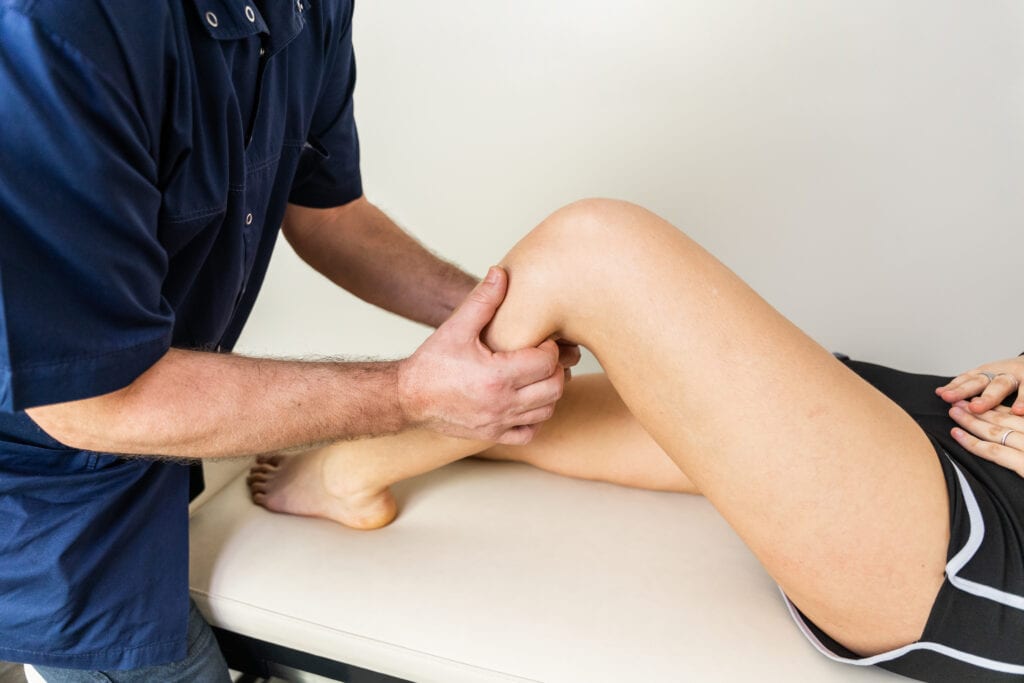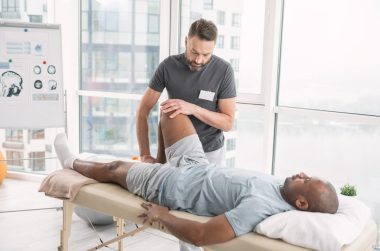Looking for Expert-Level VA Claim Answers?📱Call Us Now! 737-295-2226
In this post, I’m going to explain the Shin Splints VA Rating criteria in detail as well as my top 3 tips to get a VA rating for Medial Tibial Stress Syndrome (MTSS).
In 2021, Veterans can be rated at 0%, 10%, 20%, or 30% for Shin Splints depending on the Frequency, Severity, and Duration of your symptoms.
The maximum scheduler rating for Shin Splints is 30%, which includes the bilateral factor—meaning you have severe Shin Splints in both legs that were unresponsive to surgery.
Many Veterans suffer from Shin Splints directly related to their active duty military service; there are also a variety of other service connected physical conditions that can cause or aggravate Shin Splints.
For example, Shin Splints are a common claim for secondary service connection, especially Shin Splints secondary to knees, joints, ankles, hips, flat feet, high arches, plantar fasciitis, or obesity as an interim link.
- What are Shin Splints in Veterans?
- Top 3 Tips to Establish Service Connection for Shin Splints
- Shin Splints VA Rating Criteria
- How Does the VA Evaluate and Rate Shin Splints?
- Painful Motion Principle for Shin Splints Explained
- Are Shin Splints a VA Disability?
- Shin Splints and Secondary Service Connection
- Shin Splints Secondary to Obesity
- C&P Exam for Shin Splints
What are Shin Splints in Veterans?

The official medical name for Shin Splints is “Medial Tibial Stress Syndrome” or (MTSS).
And according to the Mayo Clinic, “Shin Splints” refers to pain along the shin bone (the tibia) — the large bone in the front of your lower leg.
Shin Splints are common in distance runners, dancers, overweight or obese individuals, and military members.
For example, one study found up to 35% of active duty military had Shin Splints.
Most cases of Shin Splints can be treated with rest, ice, and other self-care measures, to include wearing proper footwear and modifying your exercise routine, which can help prevent Shin Splints from recurring.
A doctor may recommend surgery in extreme cases although this is uncommon.
Common signs and symptoms of Shin Splints include tenderness, soreness, or pain along the inner side of your shinbone and mild swelling in your lower legs.
Are you STUCK, FRUSTRATED and UNDERRATED?
You are not alone! We are Veterans helping Veterans!
Become an Elite Member and work with our Veteran Coaches to get the rating you deserve!
Top 3 Tips to Establish Service Connection for Shin Splints
If a Veteran is going to file a VA claim for Shin Splints, he/she must present medical evidence that shows all three of the following:
- Tip #1: Make sure you have a medical diagnosis of Shin Splits (Medial Tibial Stress Syndrome) in a medical record, AND
- Tip #2: You must have a “Nexus” for service connection, meaning, your Shin Splints were caused or made worse by your active duty military service OR your shin splits are “proximately due to or aggravated by” another service connected disability rated at 0% or higher, AND
- Tip #3: You have current symptoms of Shin Splints that negatively impact your work, life, or social functioning documented in a medical record. It also helps to write a strong VA statement in support of a claim. If your Shin Splits aren’t documented in your Service Treatment Records (STRs), you should also consider obtaining a Buddy Letter.
Shin Splints VA Rating Criteria
Effective February 7, 2021, the VA revised the language of Diagnostic Code (DC) 5262 in a final rule to provide clarity on the specific criteria distinguishing the 10%, 20%, and 30% VA ratings for Shin Splints.
The VA decided NOT to adopt a rule that would require imaging evidence for a compensable rating; Shin Splints are typically diagnosed—and can be accurately assessed—by history and physical examination alone.
| 38 CFR 4.71a, DC 5262, Shin Splints VA Rating Criteria | VA Rating Percentage |
| Requiring treatment for no less than 12 consecutive months, and unresponsive to surgery and either shoe orthotics or other conservative treatment, both lower extremities (bilateral) | 30% |
| Requiring treatment for no less than 12 consecutive months, and unresponsive to surgery and either shoe orthotics or other conservative treatment, one lower extremity (unilateral) | 20% |
| Requiring treatment for no less than 12 consecutive months, and unresponsive to either shoe orthotics or other conservative treatment, one or both lower extremities (unilateral or bilateral) | 10% |
| Treatment less than 12 consecutive months, one or both lower extremities (unilateral or bilateral) | 0% |
How Does the VA Evaluate and Rate Shin Splints?

According to M21-1, the VA Rater will utilize 38 CFR 4.71a, DC 5262 for evaluating impairment of the tibia and fibula including nonunion, malunion (evaluated under the corresponding knee or ankle codes based on associated impairment), or Medial Tibial Stress Syndrome (MTSS).
Evaluations for MTSS or Shin Splints may be based on the use of conservative treatment.
For VA rating purposes, “conservative treatment” includes, but is not limited to, treatment of shin splints symptoms using the following:
- Rest
- Ice
- Elevation
- Medication
- Compression socks, and/or
- Massage
Note: MTSS is synonymous with shin splints. Related assessments, such as compartment syndrome and/or stress fractures, may also appear in treatment records. When compartment syndrome is the predominant diagnosis, however, a rating under 38 CFR 4.73, DC 5331 is warranted.
Painful Motion Principle for Shin Splints Explained
MTSS, or shin splints, is a type of joint or periarticular pathology which is a requirement for application of 38 CFR 4.59, for assignment of the minimum compensable evaluation under 38 CFR 4.71a, DC 5262 when painful motion is shown and shin splints are otherwise noncompensable, the following principles apply:
- Shin splints with pain that is not associated with motion, such as pain on palpation, are noncompensable under 38 CFR 4.59.
- The minimum compensable evaluation is warranted when painful motion due to shin splints occurs in nearby affected joints such as the ankle or knee or when shin pain or other similar pain occurs with motion. However, when a separate knee or ankle disability exists and has been compensably evaluated, do not assign a compensable evaluation under 38 CFR 4.59 for shin splints causing painful motion in an already-compensable SC knee or ankle joint.
Reference: For more information on the applicability of 38 CFR 4.59 to ratings for shin splints, see
Are Shin Splints a VA Disability?

Yes, Shin Splints are a VA disability and can be assigned a rating of 0%, 10%, 20%, or 30% under Diagnostic Code (DC) 5262, Tibia and Fibula, Impairment of Medial Tibial Stress Syndrome (MTSS) or Shin Splints.
The maximum scheduler rating for Shin Splints is 30%, which requires treatment for 12 consecutive months or more, and unresponsive to surgery and either shoe orthotics or other conservative treatment, in both lower extremities (bilateral).
However, Shin Splints are a low-value VA disability claim and it’s very common for veterans to receive a rating of 0% or 10% for the condition.
Why?
Because the 20% and 30% rating criteria for Shin Splints require the veteran’s shin splits to be “unresponsive to surgery,” meaning you’ve had surgery and it didn’t help.
While surgical treatment for shin splints is an option it is only recommended for very severe cases when more conservative methods (e.g., ice, rest, custom orthotics, weight loss) fail to relieve symptoms.
Shin Splints and Secondary Service Connection
In many cases, Shin Splints are caused by something physical, and can be rated secondary to any of the following service connected conditions:
- Weight Gain & Obesity
- Knee Conditions
- Hip Conditions
- Ankle Conditions
- Flat Feet
- High Arches
- Plantar Fasciitis
Shin Splints Secondary to Obesity
Medical research points to a link between shin splints and obesity, mainly “aggravation” not necessarily “causation.”
For example, being overweight causes the body to compensate for the extra weight by changing the way it moves.
Thus, veterans who struggle with obesity commonly have arch problems in their feet.
Obesity causes the arch to break by stretching the ligaments and tendons that hold the bones in the foot together.
And when the arch lowers, the foot may eventually fall flat.
Collapsed foot arches fail to provide adequate shock absorption which eventually leads to foot pain.
Other secondary conditions that may be caused by flat feet are pronation, plantar fasciitis, weak ankles, and shin splints.
While obesity itself is not a disability for VA rating purposes, it can be used as an “intermediate step” for secondary service connection.
C&P Exam for Shin Splints

Once you’ve filed your VA claim for Shin Splints, you’ll likely get a Compensation and Pension (C&P) exam from a private contracted medical provider in your area.
The exam will include a detailed review of your medical history as well as a physical exam of your legs.
A goniometer should be used to measure any Limitation of Range of Motion (ROM).
Be sure to tell the provider of any painful motion specifically related to your shin splints.
The C&P examiner will complete the electronic version of the Disability Benefits Questionnaire (DBQ) for Knee and Lower Leg conditions, paying specific attention to the following questions:
#1. Does the Veteran now have or has he or she ever had “shin splints” (medial tibial stress syndrome, stress fractures, chronic exertional compartment syndrome, or any other tibial and/or fibular impairment? (Answer yes or no for each extremity.)
Right lower extremity: (Yes/No)
Left lower extremity: (Yes/No)
#2. Indicate side affected by “shin splints” (medial tibial stress syndrome) if applicable.
Right lower extremity
Left lower extremity
Both
#3. Describe current symptoms of shin splints.
#4. Do shin splints affect range of motion (ROM) of knee? (Answer yes or no for each knee.)
Right knee: (Yes/No)
Left knee: (Yes/No)
If yes, complete ROM section of knee on this DBQ.
#5. Do shin splints affect ROM of ankle? (Answer yes or no for each ankle.)
Right ankle: (Yes/No)
Left ankle: (Yes/No)
If yes, complete the Ankle Conditions questionnaire to document ROM of the ankle.
#6. Indicate side affected by stress fractures if applicable.
Right lower extremity
Left lower extremity
Both
#7. Describe current symptoms of stress fractures of the lower leg.
#8. Do stress fractures affect range of motion (ROM) of knee? (Answer yes or no for each knee.)
Right knee: (Yes/No)
Left knee: (Yes/No)
If yes, complete ROM section of knee on this DBQ.
#9. Do stress fractures affect ROM of ankle? (Answer yes or no for each ankle.)
Right ankle: (Yes/No)
Left ankle: (Yes/No)
If yes, complete the Ankle Conditions questionnaire to document ROM of the ankle.
#10. Indicate side affected by chronic exertional compartment syndrome if applicable.
Right lower extremity
Left lower extremity
Both
#11. Describe current symptoms of chronic exertional compartment syndrome.
#12. Does chronic exertional compartment syndrome affect range of motion (ROM) of knee? (Answer yes or no for each knee.)
Right knee: (Yes/No)
Left knee: (Yes/No)
If yes, complete ROM section of knee on this DBQ.
#13. Does chronic exertional compartment syndrome affect ROM of ankle? (Answer yes or no for each ankle.)
Right ankle: (Yes/No)
Left ankle: (Yes/No)
If yes, complete the Ankle Conditions questionnaire to document ROM of the ankle.
Deserve a HIGHER VA Rating? WE CAN HELP.
Join our premier education-based membership program, VA Claims Insider Elite, connect with an expert-level Veteran Coach (VC) within minutes, and finally get the rating you deserve. Click the button below to get started.

Brian Reese
Brian Reese is a world-renowned VA disability benefits expert and the #1 bestselling author of VA Claim Secrets and You Deserve It. Motivated by his own frustration with the VA claim process, Brian founded VA Claims Insider to help disabled veterans secure their VA disability compensation faster, regardless of their past struggles with the VA. Since 2013, he has positively impacted the lives of over 10 million military, veterans, and their families.
A former active-duty Air Force officer, Brian has extensive experience leading diverse teams in challenging international environments, including a combat tour in Afghanistan in 2011 supporting Operation ENDURING FREEDOM.
Brian is a Distinguished Graduate of Management from the United States Air Force Academy and earned his MBA from Oklahoma State University’s Spears School of Business, where he was a National Honor Scholar, ranking in the top 1% of his class.




